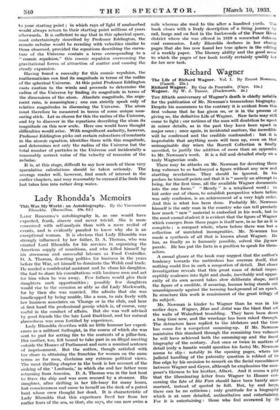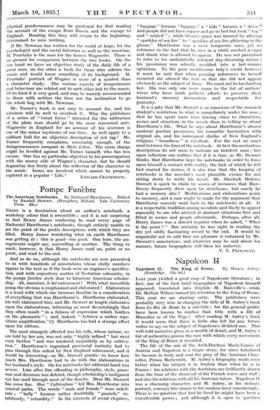Richard Wagner
THE fiftieth anniversary of Wagner's death is chiefly notable for the publication of Mr. Newman's tremendous biography. Despite his assurances to the contrary it is evident from this first volume that he has given us, or is in the process of giving us, the definitive Life of Wagner. New facts may still come to light ; our notions of the man will doubtless be upset in minor details, as in the past they have been upset in major ones ; once again, in incidental matters, the incredible will be confirmed and the credible confounded : but it is improbable that anything more will turn up, even on that unimaginable day when the Burrell Collection is finally
unveiled, to justify the addition of more than an appendix to Mr. Newman's work. It is a full and detailed study on a truly Wagnerian scale.
There may be attacks on Mr. Newman for devoting three long volumes to so hackneyed a figure without any new and startling revelations. They should be ignored. In his preface he himself points out that it is " merely an attempt to
bring, for the first time, all the available Wagner documents
into the one focus." Merely " is a misplaced word . to bid order out of chaos, to establish perspective where before was only confusion, is an achievement of a very high order. And this is what has been done. Probably Mr. Newman himself is the only man in the country who can tell precisely how much new " material is embodied in his work, but to 'the most casual student it is evident that the figure of Wagner which emerges from these pages is itself new, in so far as it is complete ; a compact whole, where before there was but a
collection of unrelated incongruities. Mr. Newman has made a synthesis of all that is known about Wagner. He
has, as finally as is humanly possible, solved the jig-saw puzzle. He has put the facts in a position to speak for them-
selves.
A casual glance at the book may suggest that the author's tendency towards the meticulous has overrun itself, that nothing could live in such a congestion of detail. But closer investigation reveals that this great mass of detail imper- ceptibly coalesces into light and shade, inevitably and appar- ently of its own accord takes slow deliberate shape, until
the figure of a credible, if amazing, human being stands out unambiguously against the teeming background of an epoch.
In structure this work is reminiscent of the great trilogy of
its subject.
Mr. Newman is kinder to Wagner than he was in his
earlier days. Wagner, Mar► and Artist was the blast that set the walls of Wahnfried trembling. They have been down
a long time now, and the wreckage has been raked through. The detractors have replied to the idolators and the time has come for a competent summing-up. If Mr. Newman maintains this standard through the remaining two volumes he will have achieved both the summing-up and the finest
biography of the century. Just once or twice in matters of detail (only a lunatic would question his facts) Mr. Newman seems to slip : notably in the opening pages, where his judicial handling of the paternity question is robbed of its fine edge by his omission to remark on the facial resemblance
between Wagner and Geyer, although he emphasizes the com- poser's likeness to his brother, Albert. And it seems a pity that the illuminating letter from Wagner to Hauser con• cerning the fate of Die Peen should have been barely sum• marized, instead of quoted in full. But, by and large, there can be no criticism ; only gratitude for a biography which is at once detailed, authoritative and entertaining. For it is entertaining : those who feel overawed by its physical ponderousness may be pardoned for first reading the, account of the escape from Russia and the voyage to England. Reading this they will return to the beginning, determined to miss nothing.
If Mr. Newman has written for the world at large, for the psychologist and the social historian as well_ as the musician, M. Pourtales is the man for•the honest Wagnerite. There is no ground for comparison between the two books. On the one hand we have an objective study of the daily life of a great man, on the other a book for those who admire the music and would know something of its background. M. Pourtales' portrait of Wagner is more of a symbol than a character study. The various aspects of temperament and behaviour are related not to each other but to the music. Of its kind it is very good, and may be warmly recommended to those with neither the time nor the inclination to go the whole hog with Mr. Newman.
Mr. Turner's book is not easy to account for, and his admirers will do well to overlook it. Why the publishers of a series, of " Great Lives " intended, for the edification of the plain man should go to the most renowned anti- Wagnerite in England for an account of his aversion is one of the minor mysteries of our time. , As well apply to a militant bull for an objective description of red rag ! Mr. Turner frequently complains, reasonably enough, of the disingenuousness rampant in Mein Leben. The same charge might be levelled against Mr. Turner himself, who has less excuse. One has no particular objection to his preoccupation with the seamy side of Wagner's character, but he should dogmatize less freely about the reflection of the character in the music. Issues are involved which cannot be properly explored in a popular " Life."
EDWARD CRANKSHAW.







































 Previous page
Previous page